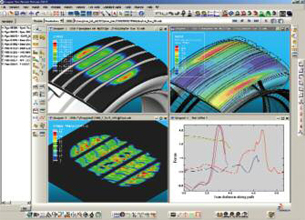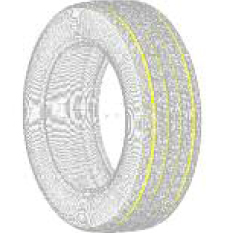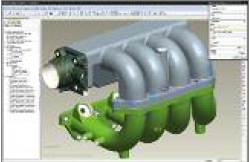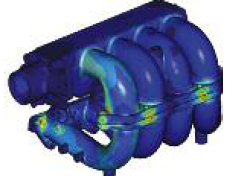Analysis Meets Design with Computer Aided Engineering Software: Part 1
Innovators are using computer aided engineering and analysis in a way that represents a change in the corporate mindset.
Latest News
July 2, 2008
By Laurie Toupin
 This is a screenshot of Cooper Tire & Rubber’s postprocessing tool. The four graphics shown aretypical “black box with expert help” outputs. |
Cooper Tire & Rubber Company (Findlay, OH) wanted its new CS4 tire line to offer two all-season tread options in sizes that would fit many of today’s most popular sedans, minivans, and crossover vehicles. But the company didn’t want to wait the traditional 18 to 24 months typically needed for product development.
By incorporating computer-aided engineering (CAE) early in the design process and providing simulation tools to its non-experts, Cooper Tire cut its time to market by almost 50 percent. This reduction was the result of a novel “analyst in the loop” design process, says Keith Sansalone, advanced research engineer in Cooper’s Research & Technology Group.
In short, FEA and CAE experts at Cooper automated several of the company’s early design procedures. If a simulation job reaches an impasse, a CAE expert sits down with a design engineer to discuss potential solutions.
A New Approach
When design engineers create a tire layout, they request a footprint analysis, says Sansalone. Among other things, they want to know whether their chosen design will satisfy Tire & Rim Association guidelines. T&RA is an independent organization established in 1903 to create standards for tires, rims, and the vehicles on which they are installed. With new tires, the static loaded radius (the distance from the road surface to the centerline of the axle) is key.
However, because this involves finicky material like rubber, even a straightforward analysis can be fraught with numerical difficulties, says Sansalone. In the footprint simulation mentioned above, for example, solving for road contact, which involves friction, can cause the automated algorithm in Abaqus Standard to exhaust the allowed number of iteration attempts. When a job reaches such a numerical impasse that the automated system can’t resolve, the analysis stops. After the designer is notified, he or she seeks the advice of a CAE expert.
“This approach really has helped because of the complexity of the problems we are looking at,” says Sansalone.
A Tool for Designers
This promotion of CAE into the design cycle of the CS4 tire illustrates the future of the simulation market.
“All of the analysis software vendors want to push analysis out to design engineers,” says Stephen Wolfe, a professional engineer and president of CAD/CAM Publishing, Inc. “Cooper Tire’s method is an example of how analysis by designers should be done. However, Cooper’s process is not based solely on off-the-shelf CAE software packages.”
Engineers use a proprietary suite of CAE applications that Cooper calls Vtech (virtual tire technology) and a collection of off-the-shelf CAE applications, including SIMULIA’s Abaqus, MSC.Patran, MSC.Nastran from MSC.Software, and MATLAB from The MathWorks. The most promising tread designs are hand-cut from a smooth-molded tire and physically tested.
Still, the migration of CAE from specialists to those who use design tools for product development “is really the biggest trend that we’ve seen for more than a decade or so, and it is continuing,” says John Buchowski, director of product management for PTC.
Aerospace and automotive manufacturers as well as makers of consumer goods are realizing that CAE is becoming a necessary part of product development.
“But there is a pretty large split between those specializing in analysis and design engineers,” says Joel Orr, vice president and chief visionary of Cyon Research. “While the designers use the data, most of them don’t spend their time analyzing.”
 The finite element mesh of Cooper’s CS4 tire shown here provides designers with atopographically accurate tread region. |
Mingling CAD with CAE
To help build a bridge across this divide, most CAD software vendors are integrating CAE with their CAD systems.
Mainstream MCAD packages from Autodesk, SolidWorks, and Siemens PLM Software have optional MCAE products integrated with their CAD software, which enable designers to perform a range of analyses — from basic “go” or “no go” design decisions to answering more complex questions.
“The three mainstream vendors ]mentioned above] are reporting that they are selling considerably more bundled CAD/CAE than they were two or three years ago,” says Orr. And everyone expects this trend to continue, he added.
As an alternative, Dassault Systemes’ SIMULIA brand provides design analysis software embedded in CATIA. PTC, on the other hand, considers its CAE tools as add-ons to Pro/ENGINEER.
The “high end” CAE market is growing as well, though not as fast, says Orr.
Fast Cars Need Fast Hardware The ease-of-use and latest algorithms in the PAM-CRASH 2G software encouraged Audi to raise its expectations for simulation design. Airbag models now routinely take into account fluid-structure interactions, leading to realistic interactions of the airbag with structures and occupants. Furthermore, prediction testing for material rupture, which usually requires high-resolution models, can now be treated using a multi-scale approach. This procedure saves days of computing time and unnecessary costs. The HP high-performance computing (HPC) system provides the computing power and speed needed to calculate this tremendous volume of data. With the HP BladeSystem c-Class architecture coupled with the HP Dynamic Smart Cooling management solution, the supercomputer requires a quarter less floor space and consumes a quarter less power than a traditional rack-based configuration. —LT |
Lower Prices & Functionality
To make these packages more attractive, vendors have brought down the cost of CAE dramatically while keeping many of what formerly would have been considered high-end capabilities such as analysis of assemblies, automated FEA mesh-generation, and animated displays or results.
For example, PTC’s products now range from $1,500 to $10,000. “Historically, the price has been in the $30,000 to $40,000 range for the same capability,” says PTC’s Buchowski.
What hasn’t changed is that price still varies with capability. Software that handles nonlinear materials, large deformations, computational fluid dynamics, and fatigue simulation generally adds to the price of a basic CAE package, says Wolfe.
Appealing to Small Companies
This bundling of CAE and CAD has especially appealed to small and medium-sized businesses (SMBs). These are the businesses that often outsource their CAE analyses if they do it at all. And, unless done carefully, outsourcing can be time consuming and costly. “As a result, it is tempting to use the design as is and take your chances,” says Orr.
An integrated CAD/CAE package readily provides the designer access to geometric data useful for making decisions. “While this approach doesn’t give all the answers, it does give meaningful results,” continues Orr.
For Cyon Research’s white paper, Classes of MCAE Software: Clarifying the Market, published in May, Orr interviewed Jason Faircloth, product manager and designer for Marin Bikes, Inc. Faircloth uses Autodesk Inventor Professional. “Before Inventor, it would typically take me 18 months to bring a new design to market,” he says. “The finite-element and motion analysis software have enabled me to almost eliminate physical prototypes. With the software, it’s now nine months, and getting faster — and the product is better. This is our future.”
The CAE capabilities of Inventor Professional enabled Faircloth to produce multiple “digital prototypes” so that the time-consuming process of physical prototyping was reduced or eliminated.
Computers & CAE-Savvy Engineers
Software vendors can’t take all the credit for the movement of CAE into the designers’ world. Two additional factors have played big parts in today’s CAE market, resulting in the reduced product development times experienced by both Cooper Tire and Marin Bikes.
 This image of a Pro/ENGINEER sessiondefines the fasteners for an intake manifoldin a study of mechanical loads. |
First, hardware is more capable. “Computers are becoming more powerful and less expensive,” says Wolfe. While this trend is not new, the expansion of CAE would not be possible without improvements in performance (see “Fast Cars Need Fast Hardware”).
Second, designers are becoming more sophisticated. Orr says that engineers are entering the workforce with at least some FEA experience. “Training in analysis is rapidly becoming universal for mechanical engineers, and they will expect the tool to be available to them to get their job done,” says Orr. “Those who don’t have it, will be at a disadvantage and will have to over-engineer products.”
Designers as Analysts
A future trend that software vendors are hoping to sell to design engineers is “abstract modeling” or black-box CAE (see “Black-Boxing CAE”). This is similar to Cooper’s tire footprint analysis where CAE experts set up a template for a class of problems and designers select the analysis option to engage the solver.
Despite the seeming advantages, some still question the wisdom of putting the power of CAE into the designer’s hands, says Orr. Naysayers caution that it is too easy for those who are not analysts to misinterpret the data and end up getting misleading results.
“However, this could be a bit of a turf issue,” Orr says. “The CAE products that are being integrated provide plenty of guidance, and vendors stand by their claims that designers can use them safely.”
Wolfe is a bit more dubious. Automatic meshing, for example, only works with tetrahedral elements, he says. Four- and six-sided elements will sometimes fail and the engineer must complete the meshing by hand. “You must know what you are doing to get meaningful answers from analytical software,” he adds.
 The same intake manifold is shown here in astress study. |
Marc Halpern, research director at Gartner Group, agrees. “Engineers should have a sense of what is going on,” he says. There is a great risk that the underlying assumptions are going to be forgotten. When one makes design decisions based entirely on a technology that assumes small strain with small deflection, for example, yet one has small strain with large deflection, the project will buckle and collapse.
When loads are applied to a surface, such as a cylinder, many finite-element modeling systems know that the load must be distributed across the finite elements that represent the surface. This sort of automation makes FEA faster and more efficient. “But in terms of automating expert guidance, it hasn’t happened,” says Wolfe, “which is the reason for Cooper’s Analyst in the Loop.”
Black-Box CAE “This hasn’t happened yet either,” says Stephen Wolfe, a professional engineer and president of CAD/CAM Publishing, Inc. Vendors might be talking about it, but not many customers are doing it. First, corporate cultural changes must take place. Expert analysts must be assigned to work with design engineers earlier in product-development schedules. But doing so is an organizational problem because analysts are often assigned to a functional department. They aren’t part of the design team and their work isn’t scheduled by product-engineering managers. “Also, there are so many different kinds of analysis, i.e., thermal, fluid flow, rigid body dynamics, fatigue. How does one cover all of them?” Wolfe asks. “A lot of art goes into engineering a product. One can’t black box that.” Marc Halpern,research director at Gartner Group, says, “We would see the biggest expansion in designers using CAE if integrated design/CAE software worked like a spell checker. However, we still need significant hardware and software advances to make this a reality.” Also, this would require upfront comprehensive modeling of operating environments as well as more systems-level thinking about simulation than is available today. —LT |
“I believe there is not a replacement anywhere for a qualified FEA analyst or someone who has been around the block a few times just to ensure that things go appropriately,” says Cooper’s Sansalone.
Even the experts aren’t experts. “Although we are supposed to be the experts, nobody really is,” Sansalone continues. “It is such an immense area of study. You can work your entire career in CAE and never use the whole spectrum of what is available.”
A change That Takes Vision
Modeling and simulation are becoming more appreciated, but conservative engineers and corporate managers are slow to embrace them. The promotion of CAE into the design process may sound simple, but in the design cycle of the CS4 tire, for example, this was the result of a change in thinking, says Sansalone.
“Many organizations view engineering, and especially research, as a non-value-added function,” he continues. “For organizations who value technology — Caterpillar is one — there is solid activity aimed at designing and analyzing in parallel. But this takes vision and planning… and funding.”
Wolfe agrees. There is a lot that engineers can do with the tools that they have now, but there is so much more that could be done. He says, “This however will require organization restructuring, training, and an understanding of how the process of design must change.”
Halpern says, “There are ways to put technology in the hands of designers, but there has to be a strong governance model.” The CAE super-user needs to be empowered and needs to have accountability for the quality of analysis done by the designers. He suggested that approval workflow and access control tools in upcoming simulation lifecycle management (SLM) tools could support this (see “Looking Ahead at CAE”).
It is surprising how much of the U.S. manufacturing industry incorporates FEA late in the project, Sansalone says. If it is written in on the design philosophy early in the process, so that it marches in parallel with the whole design process, it has the potential to save time, money, improve quality, and produce the greatest payback.
“Simulation is not a panacea,” says Sansalone. “It is a tool. But (if applied appropriately) is an inherently powerful tool because if you represent the physics correctly, it will take you where you cannot see.”
Tune in for Part 2 to see what the CAE vendors say and how they compare.
Looking Ahead at CAE 1. Simulation lifecycle management — This would make it much easier to capture and re-use simulation models, and would include content management with access control. Also, it will include workflow to better orchestrate work between designers and CAE specialists. 2. Systems simulation — In addition to the multiphysics effects (such as analyzing interactions across structural, fluid, thermal, and electromagnetic domains), this will include simulation of software logic, electronics, and mechanical effects (i.e., mechatronics). As robotics continues to mature as commercial technology, systems simulation will become increasingly important. 3. Immersive virtualization — The first step is bringing together virtual reality and CAE/simulation. The next steps will be engaging other senses such as sound and touch. For example, vehicle NVH (noise, vibration, and harshness) analysis is usually done in the frequency domain. Engineers will be able to take the results and convert those back into the sounds of a car engine/turbine or air rushing over a vehicle/aircraft body. 4. Modeling/analyzing complexity and uncertainty — This involves incorporating uncontrollable behaviors into simulation models. For example, including uncontrollable variability in manufacturing quality or variability in material characteristics. 5. Convergence of CAE with “gaming” technology — Simulation environments would behave more like games. This would involve blending game technology (such as X-Box or Playstation) with more rigorous physics-based simulation. Halpern already sees some vendors wanting to move in this direction although, he says, it is still a bit out on the timeline. |
More Info:
Autodesk
San Rafael, CA
Cooper Tire & Rubber Company
Findlay, OH
ESI Group
Paris, France
Hewlett-Packard Company
Palo Alto, CA
The MathWorks
Natick, MA
MSC.Software
Santa Ana, CA
PTC
Needham, MA
Siemens PLM
Plano, TX
SIMULIA
Providence, RI
SolidWorks
Concord, MA
Laurie Toupin is a freelance technology and science writer with a background in civil engineering. Send e-mail about this article to [email protected].
Subscribe to our FREE magazine, FREE email newsletters or both!
Latest News
About the Author
DE’s editors contribute news and new product announcements to Digital Engineering.
Press releases may be sent to them via [email protected].






